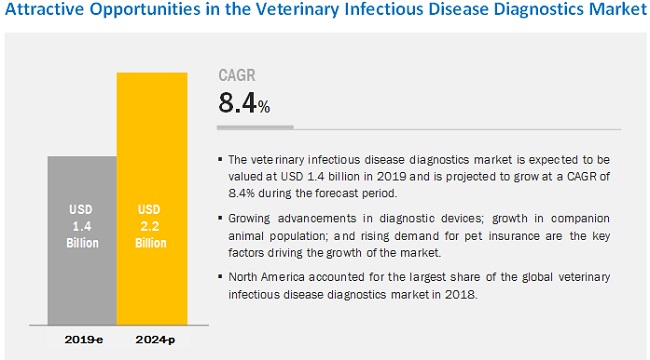
The veterinary
infectious disease diagnostics market is projected to reach USD 2.2 billion by
2024 from USD 1.4 billon in 2019, at a CAGR of 8.4%. The growth of this market is
driven by growing advancements in diagnostic devices, growth in the companion
animal population, rising demand for pet insurance, growth in the number of
veterinary practitioners in developed economies, and increasing disease control
& disease prevention measures.
In this report, the global veterinary
infectious disease diagnostics market has been segmented into technology, animal
type, end-user, and region. Based on
technology, the veterinary infectious disease diagnostics market is segmented
into immunodiagnostics, molecular diagnostics, and other veterinary diagnostic
technologies. The immunodiagnostics segment is classified further into lateral
flow assays, ELISA tests, and other immunodiagnostic products. The molecular
diagnostics segment is divided further into PCR tests, microarrays, and other
molecular diagnostics products.
The immunodiagnostics segment is expected to register the highest growth rate in
the veterinary infectious disease diagnostics market during the forecast period.
The higher preference for advanced infectious disease diagnostic products by
veterinarians, animal farm owners, government institutions & organizations,
pet owners, and laboratory technicians; growing demand for early & accurate
diagnosis; increasing preference for in-house testing; and the increasing
applications of immunodiagnostics are supporting the growth of this application
segment.
Download PDF Brochure:
https://www.marketsandmarkets.com/pdfdownloadNew.asp?id=221816584
Based on animal type, veterinary infectious disease diagnostics market is
segmented into companion animals and food-producing animals. The animal segment
is sub-segmented into viral, bacterial, parasitic, and other infections. In
2018, the companion animals segment accounted for the larger share of the
veterinary infectious disease diagnostics market. Increasing pet ownership
(especially in developed countries), growing penetration of pet insurance,
rising number of veterinary practitioners globally, and the increasing animal
disease control and disease prevention measures will continue driving the
growth of this segment.
Based on end-user, the veterinary
infectious disease diagnostics market is segmented into reference
laboratories, veterinary hospitals & clinics, research institutes &
universities, and point-of-care/in-house testing. The reference laboratories
segment was the largest end-user of the veterinary infectious disease
diagnostics market in 2018. The large share of this end-user segment is mainly
due to a large number of samples received for analysis in reference
laboratories from small and large animal practices.
On the basis of region, the market is
segmented into North America (US and Canada), Europe (Germany, UK, France,
Italy, Spain, and the Rest of Europe), Asia Pacific (China, Japan, India, and
Rest of Asia Pacific), Latin America (Brazil, Mexico, and Rest of Latin America)
and Middle East & Africa. North America accounted for the largest share of
the veterinary infectious disease diagnostics market in 2018. Factors such as
the increasing demand for prevention, early diagnosis & treatment of
veterinary infectious disease diagnostics, growing pet insurance industry,
rising veterinary healthcare expenditure, growing awareness of zoonotic
diseases, and the growing number of veterinary practices are expected to drive
the veterinary infectious disease diagnostics market in the region.


